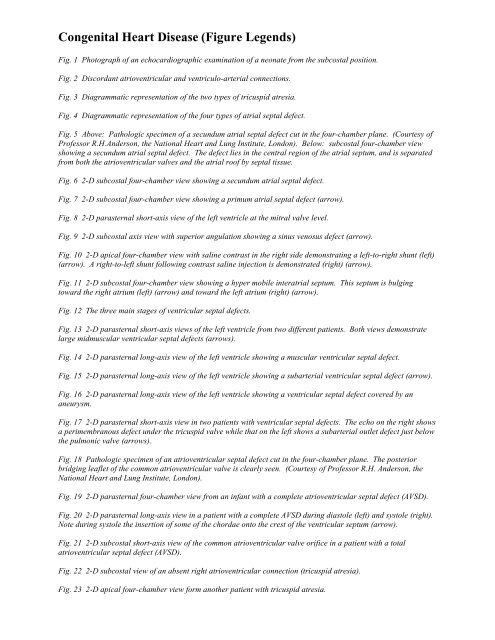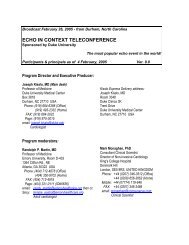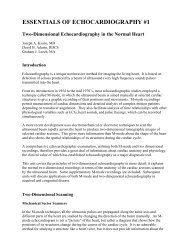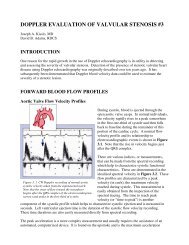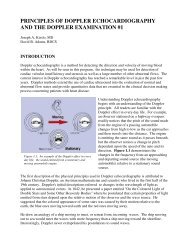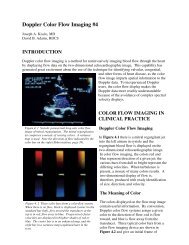ESSENTIALS OF ECHOCARDIOGRAPHY #4 - Echo in Context
ESSENTIALS OF ECHOCARDIOGRAPHY #4 - Echo in Context
ESSENTIALS OF ECHOCARDIOGRAPHY #4 - Echo in Context
You also want an ePaper? Increase the reach of your titles
YUMPU automatically turns print PDFs into web optimized ePapers that Google loves.
Congenital Heart Disease (Figure Legends)Fig. 1 Photograph of an echocardiographic exam<strong>in</strong>ation of a neonate from the subcostal position.Fig. 2 Discordant atrioventricular and ventriculo-arterial connections.Fig. 3 Diagrammatic representation of the two types of tricuspid atresia.Fig. 4 Diagrammatic representation of the four types of atrial septal defect.Fig. 5 Above: Pathologic specimen of a secundum atrial septal defect cut <strong>in</strong> the four-chamber plane. (Courtesy ofProfessor R.H.Anderson, the National Heart and Lung Institute, London). Below: subcostal four-chamber viewshow<strong>in</strong>g a secundum atrial septal defect. The defect lies <strong>in</strong> the central region of the atrial septum, and is separatedfrom both the atrioventricular valves and the atrial roof by septal tissue.Fig. 6 2-D subcostal four-chamber view show<strong>in</strong>g a secundum atrial septal defect.Fig. 7 2-D subcostal four-chamber view show<strong>in</strong>g a primum atrial septal defect (arrow).Fig. 8 2-D parasternal short-axis view of the left ventricle at the mitral valve level.Fig. 9 2-D subcostal axis view with superior angulation show<strong>in</strong>g a s<strong>in</strong>us venosus defect (arrow).Fig. 10 2-D apical four-chamber view with sal<strong>in</strong>e contrast <strong>in</strong> the right side demonstrat<strong>in</strong>g a left-to-right shunt (left)(arrow). A right-to-left shunt follow<strong>in</strong>g contrast sal<strong>in</strong>e <strong>in</strong>jection is demonstrated (right) (arrow).Fig. 11 2-D subcostal four-chamber view show<strong>in</strong>g a hyper mobile <strong>in</strong>teratrial septum. This septum is bulg<strong>in</strong>gtoward the right atrium (left) (arrow) and toward the left atrium (right) (arrow).Fig. 12 The three ma<strong>in</strong> stages of ventricular septal defects.Fig. 13 2-D parasternal short-axis views of the left ventricle from two different patients. Both views demonstratelarge midmuscular ventricular septal defects (arrows).Fig. 14 2-D parasternal long-axis view of the left ventricle show<strong>in</strong>g a muscular ventricular septal defect.Fig. 15 2-D parasternal long-axis view of the left ventricle show<strong>in</strong>g a subarterial ventricular septal defect (arrow).Fig. 16 2-D parasternal long-axis view of the left ventricle show<strong>in</strong>g a ventricular septal defect covered by ananeurysm.Fig. 17 2-D parasternal short-axis view <strong>in</strong> two patients with ventricular septal defects. The echo on the right showsa perimembranous defect under the tricuspid valve while that on the left shows a subarterial outlet defect just belowthe pulmonic valve (arrows).Fig. 18 Pathologic specimen of an atrioventricular septal defect cut <strong>in</strong> the four-chamber plane. The posteriorbridg<strong>in</strong>g leaflet of the common atrioventricular valve is clearly seen. (Courtesy of Professor R.H. Anderson, theNational Heart and Lung Institute, London).Fig. 19 2-D parasternal four-chamber view from an <strong>in</strong>fant with a complete atrioventricular septal defect (AVSD).Fig. 20 2-D parasternal long-axis view <strong>in</strong> a patient with a complete AVSD dur<strong>in</strong>g diastole (left) and systole (right).Note dur<strong>in</strong>g systole the <strong>in</strong>sertion of some of the chordae onto the crest of the ventricular septum (arrow).Fig. 21 2-D subcostal short-axis view of the common atrioventricular valve orifice <strong>in</strong> a patient with a totalatrioventricular septal defect (AVSD).Fig. 22 2-D subcostal view of an absent right atrioventricular connection (tricuspid atresia).Fig. 23 2-D apical four-chamber view form another patient with tricuspid atresia.


